Solar eclipse of July 20, 1963
| Solar eclipse of July 20, 1963 | |
|---|---|
 Map | |
| Type of eclipse | |
| Nature | Total |
| Gamma | 0.6571 |
| Magnitude | 1.0224 |
| Maximum eclipse | |
| Duration | 100 sec (1 m 40 s) |
| Coordinates | 61°42′N 119°36′W / 61.7°N 119.6°W |
| Max. width of band | 101 km (63 mi) |
| Times (UTC) | |
| Greatest eclipse | 20:36:13 |
| References | |
| Saros | 145 (19 of 77) |
| Catalog # (SE5000) | 9427 |
A total solar eclipse occurred on July 20, 1963. A solar eclipse occurs when the Moon passes between Earth and the Sun, thereby totally or partly obscuring the image of the Sun for a viewer on Earth. A total solar eclipse occurs when the Moon's apparent diameter is larger than the Sun's, blocking all direct sunlight, turning day into darkness. Totality occurs in a narrow path across Earth's surface, with the partial solar eclipse visible over a surrounding region thousands of kilometres wide.
In popular culture
The eclipse was featured in the comic strip Peanuts (July 15–20, 1963), with Linus demonstrating a safe way of observing the eclipse as opposed to looking directly at the eclipse. It also served an important function in the plots of two Stephen King novels, Gerald's Game (1992) and Dolores Claiborne (1992) and was featured in a season 3 episode of Mad Men titled "Seven Twenty Three" (2009).[1] John Updike mentioned the eclipse in his 1968 novel Couples, saying "[o]nly one other time had been so ominous [in those years], the Wednesday in October of 1962 when Kennedy had faced Khrushchev over Cuba".[2]
Related eclipses
Solar eclipses of 1961-1964
Each member in a semester series of solar eclipses repeats approximately every 177 days and 4 hours (a semester) at alternating nodes of the Moon's orbit.
| Descending node | Ascending node | |||||
|---|---|---|---|---|---|---|
| Saros | Map | Saros | Map | |||
| 120 | 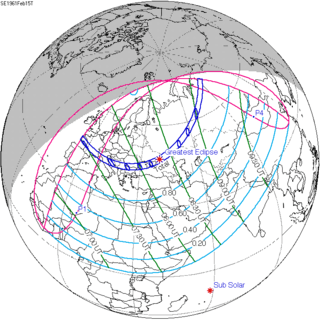 February 15, 1961 Total |
125 |  August 11, 1961 Annular | |||
| 130 |  February 5, 1962 Total |
135 | 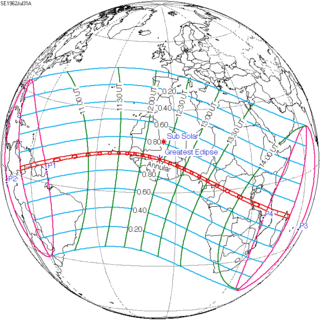 July 31, 1962 Annular | |||
| 140 |  January 25, 1963 Annular |
145 |  July 20, 1963 Total | |||
| 150 | 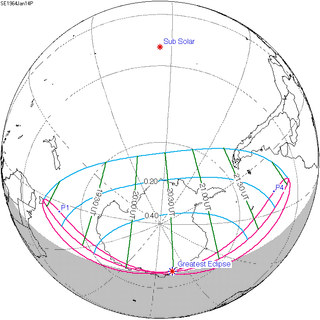 January 14, 1964 Partial |
155 |  July 9, 1964 Partial | |||
| Partial solar eclipses of June 10, 1964 and December 4, 1964 belong in the next lunar year set. | ||||||
Saros 145
This solar eclipse is a part of Saros cycle 145, repeating every 18 years, 11 days, containing 77 events. The series started with partial solar eclipse on January 4, 1639, and reached a first annular eclipse on June 6, 1891. It was a hybrid event on June 17, 1909, and total eclipses from June 29, 1927 through September 9, 2648. The series ends at member 77 as a partial eclipse on April 17, 3009. The longest eclipse will occur on June 25, 2522, with a maximum duration of totality of 7 minutes, 12 seconds. [3]
| Series members 16–26 occur between 1901 and 2100 | ||
|---|---|---|
| 16 | 17 | 18 |
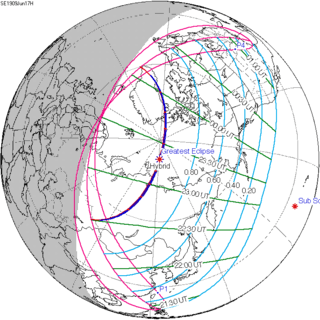 June 17, 1909 |
 June 29, 1927 |
 July 9, 1945 |
| 19 | 20 | 21 |
 July 20, 1963 |
 July 31, 1981 |
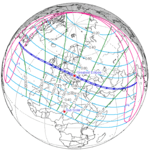 August 11, 1999 |
| 22 | 23 | 24 |
 August 21, 2017 |
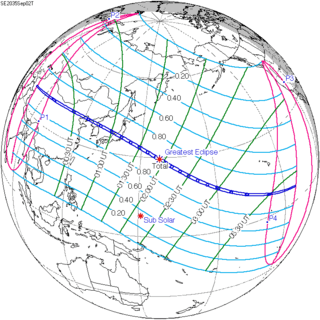 September 2, 2035 |
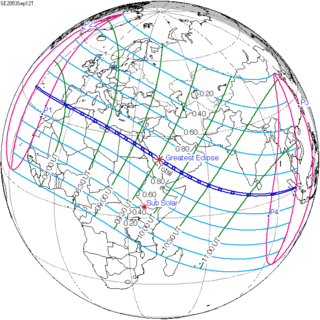 September 12, 2053 |
| 25 | 26 | |
 September 23, 2071 |
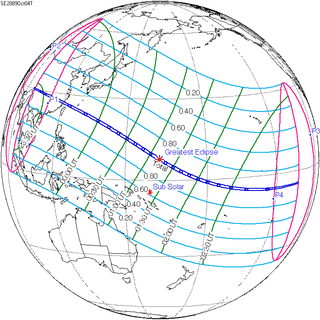 October 4, 2089 | |
Notes
- ↑ Episode 7: Seven Twenty Three (Details tab) http://www.amctv.com/shows/mad-men/episodes/season-3/seven-twenty-three
- ↑ Updike, John, Couples (Albert A. Knopf, 1968) pp. 223-4. "[I]t had been ninety per cent at their latitude [near Boston]. An invisible eater moved through the sun's disc amid a struggle of witnessing clouds. The dapples of light beneath the elm became crescent-shaped .... [A] sideways eyebrow ...." Retrieved 2013-04-24.
- ↑ Espenak, Fred (Project & Website Manager), Statistics for Solar Eclipses of Saros 145, NASA, updated 2009 September 26.
References
- Earth visibility chart and eclipse statistics Eclipse Predictions by Fred Espenak, NASA/GSFC
| Wikimedia Commons has media related to Solar eclipse of 1963 July 20. |
